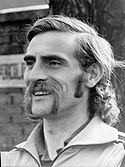Mistrzostwa Europy w Lekkoatletyce 1974 – bieg na 10 000 m mężczyzn
| |||
Bieg na dystansie 10 000 metrów mężczyzn był jedną z konkurencji rozgrywanych podczas XI Mistrzostw Europy w Rzymie. Rozegrano od razu bieg finałowy 2 września 1974 roku. Zwycięzcą tej konkurencji został reprezentant Niemieckiej Republiki Demokratycznej Manfred Kuschmann. W rywalizacji wzięło udział trzydziestu jeden zawodników z siedemnastu reprezentacji.
Rekordy
| Rekord świata | 27:30,8 | Londyn, Wielka Brytania | 13.07.1973[1] | |
| Rekord Europy | 27:30,8 | Londyn, Wielka Brytania | 13.07.1973 | |
| Rekord mistrzostw | 27:52,78 | Helsinki, Finlandia | 10.08.1971 |
Wyniki
Finał
| Miejsce | Zawodnik | Czas |
|---|---|---|
| 1 | 28:25,75 | |
| 2 | 28:25,79 | |
| 3 | 28:25,05 | |
| 4 | 28:27,75 | |
| 5 | 28:29,14 | |
| 6 | 28:29,19 | |
| 7 | 28:29,23 | |
| 8 | 28:36,00 | |
| 9 | 28:36,6 | |
| 10 | 28:37,4 | |
| 11 | 28:41,2 | |
| 12 | 28:42,8 | |
| 13 | 28:44,4 | |
| 14 | 28:51,8 | |
| 15 | 29:04,8 | |
| 16 | 29:06,0 | |
| 17 | 29:07,4 | |
| 18 | 29:08,4 | |
| 19 | 29:21,6 | |
| 20 | 29:23,2 | |
| 21 | 29:32,6 | |
| 22 | 29:41,0 | |
| 23 | 29:45,6 | |
| 24 | 29:49,6 | |
| – | DNF | |
| – | DNF | |
| – | DNF | |
| – | DNF | |
| – | DNF | |
| – | DNF | |
| – | DNF |
Przypisy
- ↑ Progression of IAAF World Records. 2015 Edition, IAAF, s. 94 [dostęp 2019-11-03] (ang.).
Bibliografia
- Berlin 2018 Leichtatletik – EM Statistics Handbook, European Athletics, s. 547 [dostęp 2019-11-03] [zarchiwizowane z adresu 2019-09-14] (ang.).
- European Athletics Championships – Roma 1974, European Athletics [dostęp 2019-11-03] (ang.).
- Od Borzowa do Skowronka. „Lekkoatletyka”. XIX (11), s. 8, listopad 1974. Zygmunt Głuszek (red. naczelny). Warszawa: RSW Prasa (pol.).
|
Media użyte na tej stronie
Pictograms of Olympic sports – . This is an unofficial sample picture. Images of official Olympic pictograms for 1948 Summer Olympics and all Summer Olympics since 1964 can be found in corresponding Official Reports.
An icon that represents a gold medal
An icon that represents a silver medal
An icon that represents a bronze medal
Flaga Finlandii
Autor: SanchoPanzaXXI, Licencja: CC BY-SA 4.0
Flag of Spain during the Spanish State. It was adopted on 11 October 1945 with Reglamento de Banderas Insignias y Distintivos (Flags, Ensigns and Coats of Arms Bill)
Flag of Romania, (21 August 1965 - 22 December 1989/officialy 27 December 1989).
Construction sheet of the Flag of Romania as depicted in Decree nr. 972 from 5 November 1968.
- l = 2/3 × L
- C = 1/3 × L
- S = 2/5 × l
Flag of Romania, (21 August 1965 - 22 December 1989/officialy 27 December 1989).
Construction sheet of the Flag of Romania as depicted in Decree nr. 972 from 5 November 1968.
- l = 2/3 × L
- C = 1/3 × L
- S = 2/5 × l
Flag of the Socialist Federal Republic of Yugoslavia (1946-1992).
The design (blazon) is defined in Article 4 of the Constitution for the Republic of Yugoslavia (1946). [1]
Flag of the Socialist Federal Republic of Yugoslavia (1946-1992).
The design (blazon) is defined in Article 4 of the Constitution for the Republic of Yugoslavia (1946). [1]
Flag of Portugal, created by Columbano Bordalo Pinheiro (1857-1929), officially adopted by Portuguese government in June 30th 1911 (in use since about November 1910). Color shades matching the RGB values officially reccomended here. (PMS values should be used for direct ink or textile; CMYK for 4-color offset printing on paper; this is an image for screen display, RGB should be used.)




















